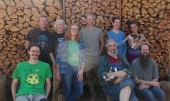
 3
3




Nina Surya wrote:Somehow I'm convinced the bell should be covered with one single plate.
Have you tried two plates next to each other? If so, how did it work out for you?

 4
4




Julian Adam wrote:I see you mention tomettes. Are you French(-speaking)? If so, maybe try looking for 'plaque d'égout en fonte ductile'. Based on the fact that the usual barrel over the J-tube can last for many years, I would think this would work well, assuming you put some stove rope / seal in the groove.
* Follow your curiosity , Do what you Love *
Permaculture page on Simperi website | Guides for a more intuitive life












 4
4




Cristobal Cristo wrote:
These plates are designed to work in an assembly of usually at least 2 or more in the cooking stoves where the fire is hitting them from the under. The perimeter of the plates is sealed with refractory wool (in older times they were just laid in the bed of clay I think). They join to each other with a protruding lip. Hot gases are supposed to go the the lower pressure area which is the chimney exit. I grew up with plates like that and I do not remember any leaks or smoke coming through the dry joints never ever. I have some brand new ones that I'm going to use on my kitchen stove so I can send you close up images if you like.
 VERY inspiring/tempting to modify the present version in the future like that...hmmm!)
VERY inspiring/tempting to modify the present version in the future like that...hmmm!)
* Follow your curiosity , Do what you Love *
Permaculture page on Simperi website | Guides for a more intuitive life
 5
5




 6
6




 4
4




Fox James wrote:Hi Nina, I dont think you will get anywhere near 1000c under your top plate, maybe 500c at peak burn.












 3
3




Fox James wrote:Hi Nina, I dont think you will get anywhere near 1000c under your top plate, maybe 500c at peak burn.
Your stove may produce closed to 1000c at the base of the riser.
You present choice of wire in concrete is not a good one because metal and cement expand at different rates and often cause severe cracking when heated above 300c then the concrete its self will break down at around 250-275 c becoming weak and fragile!
So I have a suggestion that may work for you,, a ceramic glass recovered from an electric cooker hob, that is good for 750 c and very stable.
On my own J tube I use a 10mm steel plate with a centre cut out, that works very well but only because the cut out allows the top to move without the edges distorting.
I do explain this in one of my videos
I also notice that you might be using some sort of ceramic fibre to seal your present top?
If that is the case then please remove it as that is not a heathy option in your living space.
* Follow your curiosity , Do what you Love *
Permaculture page on Simperi website | Guides for a more intuitive life












 3
3




Cristobal Cristo wrote:
The masonry stoves I grew up with were all coal fired so it was easier to get higher temps and the heat was more condensed due to the stove design.
Sometimes the plate would start glowing in the center - indicating 500-600 C temperature which they withstood just fine.
Also not all cast iron has the same quality. I was using some Chinese made hot plate sold by some popular brand. It was placed on my outside experimental stove and developed a long thin crack (all way through) after a tennth fire.
Glass sounds good too and as a side effect you can look inside from above!
* Follow your curiosity , Do what you Love *
Permaculture page on Simperi website | Guides for a more intuitive life
 4
4





|
A nature documentary filmed entirely in a pet store. This tiny ad was in an aquarium
The new gardening playing cards kickstarter is now live!
https://www.kickstarter.com/projects/paulwheaton/garden-cards
|








